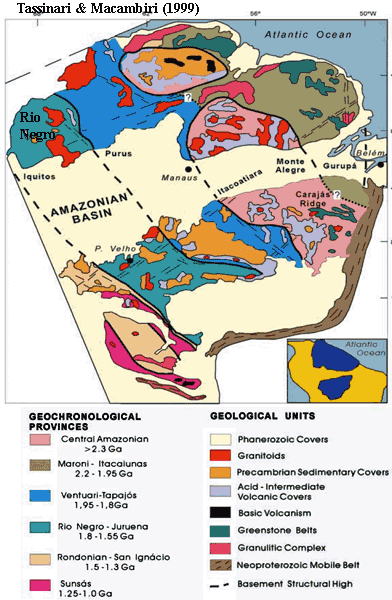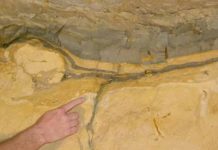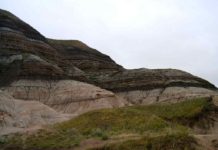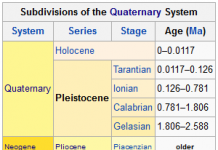The Paleoproterozoic is the first of the three sub-divisions (eras) of the Proterozoic occurring between 2,500 to 1,600 million years ago. This is when the continents first stabilized. This is also when cyanobacteria evolved, a type of bacteria which uses the biochemical process of photosynthesis to produce energy and oxygen.
Paleontological evidence on the Earth’s rotational history suggests that ~1.8 billion years ago, there were about 450 days in a year, implying 20 hour days.
Geography
Modern Plate tectonics began with the Paleoproterozoic. The Paleoproterozoic was the era of continental shield formation. By and large, the Earth’s Archean crust seems to have been both fragmented and somewhat unstable. Some paleogeographers assert that an episode of continent formation — in fact a supercontinent — was present at the end of the Archean. Kump & Barley (2007). However, if that was the case, then those continents were unstable and disappeared without a trace over the next few hundred My. The majority view is that modern style continents and familiar plate tectonics began not long before the Paleoproterozoic.
Continental shields formed from small cratons. It was during the Paleoproterozoic that small islands of crust were first stitched together to form the stable nuclei of the continents we know today. This may something of an overstatement, since relatively broad islands of Archean stability are found in the rocks northeastern Canada and Greenland (the Laurentian or Canadian Shield), Western Australia (Pilbarra Craton), and South Africa (Kapvaal Craton). These became the nuclei of the North American, Australian, and (in part) African continents, respectively. However, even in these cases, the continental craton in its present form was the product of suturing several smaller units. That suturing process largely occurred in the Paleoproterozoic. In other cases (e.g., India, South America, and North China), both crust and shield were largely products of the Paleoproterozoic.
Now that we have extruded this patently over-broad generalization, we had best defend the thesis with some concrete examples.
For example, the core of South America formed around Amazonia in the Paleoproterozoic. The geologically stable core of South America is the Amazonian craton, roughly coterminous with northern and central Brazil and the inland areas of Venezuela, both Guyanas, and Suriname. Most of western South America is composed of ephemeral orogenic mountain ranges which come and go on timescales of a few 100 My. Other bits and pieces have joined (Uruguay) or left (Central Texas?) Amazonia at various times in the geological past. However, the unchanging hub of all this activity was Amazonia. The only other significant cratons now associated with South America, the São Francisco and Rio de la Plata, are both immigrants from Africa. Iacumin et al. (2001).
The only large stretches of Archean basement remaining in Amazonia are located in the eastern section of Amazonia, mostly in the southeastern corner. Most of the rest of Amazonia was intruded and sutured together in the Paleoproterozoic. The only significant exception is the northwestern Rio Negro Province, which lies along the Brazilian-Columbian border. This province formed as an extension of Amazonia in the Mesoproterozoic. Tassinari & Macambira (1999); Sial et al. (1999). For the subsequent development of the region, Brito Neves et al. (1999).
Baltica, the core of Europe, formed from the merger of three cratons in the Paleoproterozoic. The formation of Baltica – the continent which was to become Europe — is one of the best-known examples. Baltica formed in the Paleoproterozoic from the fusion of three cratons: Fennoscandia (Scandinavia, the Baltics, Belarus, Eastern Poland, part of Scotland, and northern European Russia), Volgo-Uralia (the Volga Basin of Russia), and Sarmatia (the Trans-Caucasus region, the Ukraine, Moldavia and part of Romania). Gee & Stephenson (2006). The process of consolidation was complete by the end of the Paleoproterozoic. Virtually all further growth in the Proterozoic came by way of extensional tectonics and the incorporation of bits and pieces of other adjacent continents. Bingen et al. (2008).
India has a similar history. Similarly, India appears to be an amalgamation of four cratons. One of these is a small, late accretion to the southern tip (southern Tamil Nadu and Kerala). The rest consists of three Archean cratons which consolidated at the end of the Paleoproterozoic. Sankaran (1999).
The shift in continent-building style is correlated with a shift in large volcanic belts from marine to terrestrial settings. Recently Kump & Barley (2007), devised an ingenious test of the general concept. They collected a large database of reasonably characterized “large igneous provinces.” LIPs are broad areas of volcanic activity. They are usually manifestations of the chafing and irritation which occurs when two cratons come in contact. During the Archean, the vast majority (80% or more) of LIPs happened under water. At the beginning of the Proterozoic, the proportions abruptly reverse. About 80% of known Proterozoic LIPs were terrestrial. The most parsimonious explanation is that cratons were now consolidating, so that the boundaries between adjacent cratons most often lay in the interior of larger masses — continents.
The trigger may have been the accumulation of a critical amount of rigid continental crust. In fact, something more fundamental may have happened — a change in the tectonic behavior of cratons somewhat analogous to a change of state between two crystal forms. The break between Archean and Proterozoic LIP locations is quite sharp, and the ~80% level is fairly steady for the rest of Earth history. The Early Paleoproterozoic is also the earliest time that normal plate boundaries, boundaries between essentially rigid crust elements, are seen in the geological record. Stanley (1998). Stanley also notes that the total volume of continental crust first approached present value at the end of the Archean. It seems likely that the volume of continental crust, the formation of continental shields, and the development of “normal” plate tectonics are related, although the mechanics have not been worked out.
Paleoatmosphere
Before the significant increase in atmospheric oxygen almost all life that existed was anaerobic, that is, the metabolism of life depended on a form of cellular respiration that did not require oxygen.
Free oxygen in large amounts is toxic to most anaerobic bacteria. It is widely believed that the majority of existent anaerobic life on Earth died off. The only life that remained was either resistant to the oxidizing and poisonous effects of oxygen, or spent its life-cycle in an oxygen-free environment. This main event is called the oxygen catastrophe.
Lifeforms
Geological events
During this era the earliest global-scale continent-continent collisional belts developed.
These continent and mountain building events are represented by the 2.1-2.0 Ga (Ga = billion year) Transamazonian and Eburnean Orogens in South America and West Africa; the ~2.0 Ga Limpopo Belt in southern Africa; the 1.9–1.8 Ga Trans-Hudson, Penokean, Taltson–Thelon, Wopmay, Ungava and Torngat orogens in North America, the 1.9–1.8 Ga Nagssugtoqidain Orogen in Greenland; the 1.9–1.8 Ga Kola–Karelia, Svecofennian, Volhyn-Central Russian, and Pachelma Orogens in Baltica (Eastern Europe); the 1.9–1.8 Ga Akitkan Orogen in Siberia; the ~1.95 Ga Khondalite Belt and ~1.85 Ga Trans-North China Orogen in North China.
These continental collisional belts are interpreted as having resulted from 2.0-1.8 Ga global-scale collisional events that led to the assembly of a Paleo-Mesoproterozoic supercontinent named “Columbia” or “Nuna”.













